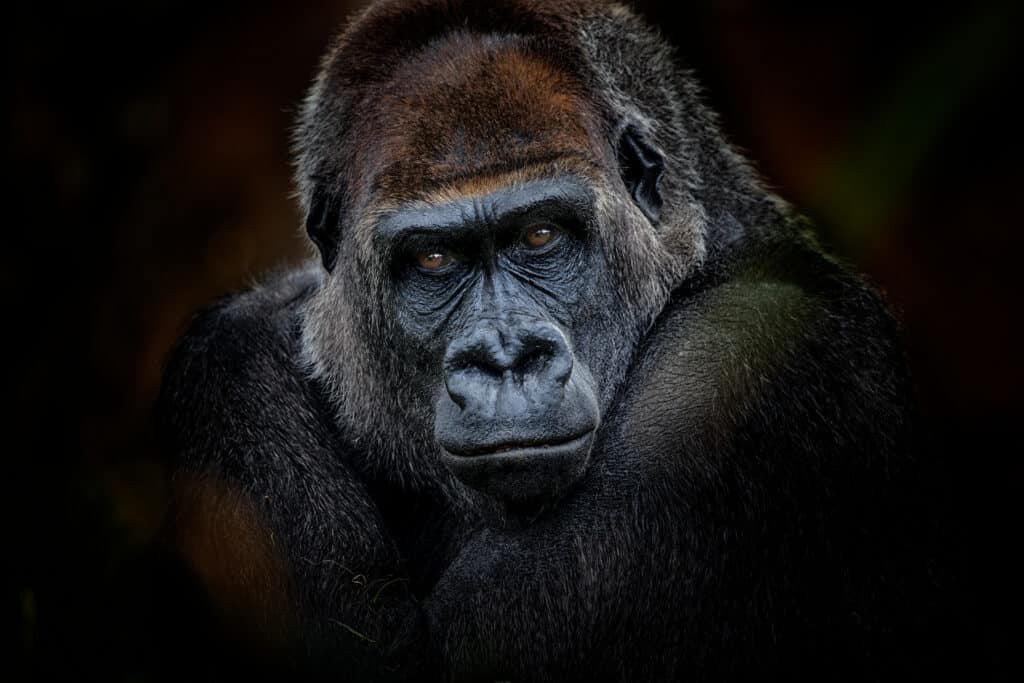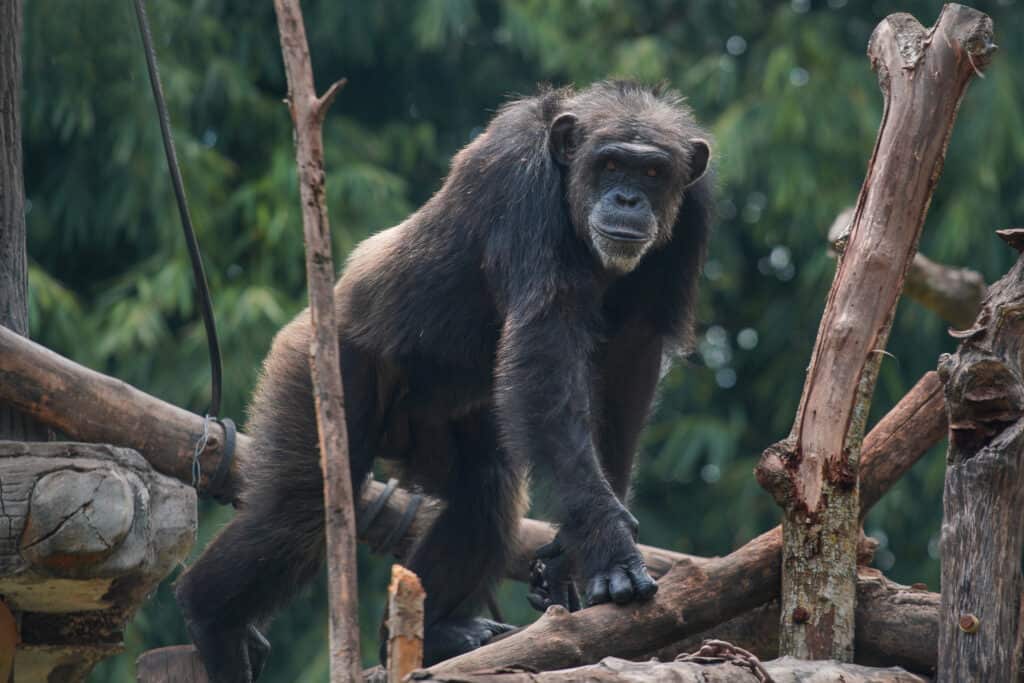Many people look at primates and automatically think they’re monkeys, so a discussion on apes vs. monkeys is necessary. But with over 200 species of monkeys and only 20 species of apes, it is easy to make a mistake. So, learn key distinctions between monkeys and apes to tell them apart. For example, although monkeys and apes are both primates, as humans are, apes are more evolved and similar to humans than monkeys. So, continue reading to learn about apes vs. monkeys.
Are Monkeys and Apes Different?

Some monkeys have shoulder joints and can swing across branches, but most do not or prefer to run across branches.
©PhotoZeli/Shutterstock.com
Monkeys and apes are similar, but they are also very different. Monkeys and apes are primates, forming part of the human family tree. To tell our relatives apart, you should look for a tail. The majority of monkeys have a tail, while apes do not. Monkeys are also generally smaller than apes, which are larger and have broad shoulders. Examples of popular apes include chimpanzees, gorillas, and orangutans.
Apes are also more similar to humans. For example, apes have an appendix, while monkeys do not. Apes are also generally smarter than monkeys. This intelligence is evident where most apes use tools when completing tasks, like opening nuts or fruit with hard exteriors. People have also trained some apes to use human sign languages.
Comparing Apes vs. Monkey

Apes are generally smarter than monkeys.
©Jiri Fejkl/Shutterstock.com
| Apes | Monkey | |
|---|---|---|
| Tails | Apes do not have tails | Most species of monkeys have tails |
| Shape and Size | Apes have a shape and skeleton similar to that of a human. They have broad chests and shoulder joints. | Monkeys are smaller in size and have narrow chests. Their skeletal structure is similar to a mid-sized mammal. |
| Movement | Apes can walk upright and swing from branch to branch. | Monkeys prefer to walk on all fours and often run from branch to branch. |
| Intelligence | Apes have larger brains. They are extremely intelligent and can communicate and use tools. | Monkeys have smaller brains than apes. They are intelligent as well, but not as intelligent as apes. |
| Communication | Apes have advanced cognitive and language skills. Some apes have been taught to communicate with sign language, body movements, and technology. | Monkeys use sound and body language to communicate. |
| Location | Apes are only found in Africa and Asia. | Monkeys are found in Africa, Asia, Central America, South America, and Europe. |
The Key Differences Between Apes vs. Monkeys
The key differences between apes and monkeys are intelligence and tails. Other differences include location, joints, size, joints, and movements.
The simplest way to tell the difference is by looking for a tail, as apes do not have tails, and most monkey species have tails. Apes are also larger than monkeys and have body shapes and sizes similar to that and humans. Monkeys have body sizes and shape similar to that of mid-sized mammals.
Some monkeys have shoulder joints and can swing across branches, but most do not or prefer to run across branches. Apes have shoulder joints and like to swing across branches. An additional physical difference that is not visible is that apes have an appendix while monkeys do not. Apes can communicate better than monkeys and show an ability to use language through sign language and technology. Lastly, apes live in Africa and Asia, whereas monkeys live on these continents and in Europe and Central and South America.
Apes vs. Monkeys: Intelligence

Researchers confirm that apes are incredibly smart as they use tools, have more complex social interactions, and can learn easily.
©Ari Wid/Shutterstock.com
Although this is not a physically distinct way to tell monkeys and apes apart, it may be the most essential and distinctive difference between monkeys and apes. Monkeys have not evolved as much as apes, which means their brains are more primitive. However, this should not diminish their intelligence. All primates are social animals and some of the most clever, if not the most intelligent, land mammals.
When measuring intelligence, researchers consider the ability to problem solve, learn, plan, comprehend, and communicate. Researchers confirm that apes are incredibly smart as they use tools, have more complex social interactions, and can learn easily. An example of this intelligence is wild chimpanzees. Wild chimpanzees typically have 20 different tools and tool use behaviors. For example, chimpanzees use sticks to get ants out of bark or to reach honey in tight spaces. They also use a stone hammer and anvil to open nuts.
Additionally, apes have been able to learn American Sign Language. In 1972, Koko, a gorilla, had a vocabulary of over 1,000 ASL signs and could understand 2,000 spoken English words. Koko was estimated to have an IQ level between 70 and 95. The average human has an IQ level of 100.
Monkeys are also clever, use tools, and are teachable, but they don’t appear to have quite the same capacity as apes.
Apes vs. Monkeys: Tails

Monkeys can use their tail to grasp or hold onto objects.
©Nick Fox/Shutterstock.com
Most monkeys have tails, whereas apes do not. An example of a monkey without a tail is the barbary macaque. Most new world monkeys have a prehensile tail. They can use their tail to grasp or hold onto objects. This ability enables many monkey species to live in the canopies of forests because they can use their tail to hang. At the same time, they gather fruit with their hands. However, most old-world monkeys have tails that are not as advanced as the tails of new-world monkeys. For example, Colobus monkeys cannot rely on their tails to climb, while baboons have tails with no grasping ability.
Monkeys vs. Apes: Location

Some old-world monkeys, like the Macaques, live in various habitats, including tropical rainforests, mountains, and the Asian plains.
©Syda Productions/Shutterstock.com
Apes are not found in the Americas but only in Africa and Asia. Gorillas come from Africa, and orangutans live in Asia. Apes, as well as monkeys, used to live in Europe, but they have become extinct. Humans now live all over the planet, supposedly evolved out of Africa, and moved across the globe as other apes did.
In contrast, monkey locations include vast regions in Africa, Europe, Asia, and the Americas. However, old-world monkeys are from Africa, Europe, and Asia. New world monkeys are native to Mexico, Central America, and South America. For example, mandrills, which are old-world monkeys, are indigenous to Africa. On the other hand, white-faced capuchins and tamarins are new-world monkeys that originate from South America.
Apes vs. Monkeys: Size

The chimpanzee (Pan troglodytes), also known as the common chimpanzee, is a species of great ape native to the forests of tropical Africa.
©Dhimas Satriaa/Shutterstock.com
Apes are more similar to humans, so they are generally much larger than monkeys. The largest ape species are gorillas, weighing up to 500 pounds. Gibbons are the smallest ape species and are smaller than some of the larger monkey species. But, the smallest of the great apes is the female bonobo. The largest monkey species is the mandrill which can weigh up to 119 pounds. Pygmy marmosets are the smallest monkey species and weigh roughly 4 ounces.
Similar to humans, apes and monkeys show sexual dimorphism. Sexual dimorphism is the difference between males and females of the same species. This dissimilarity is often due to mating competition. Clear examples of this in apes are the weight discrepancies in gorillas. Male gorillas weigh up to 430 pounds, and females weigh 220 pounds. The same applies to some monkey species. For example, male mandrills weigh up to 82 pounds, while females weigh up to 32 pounds.
Apes vs. Monkeys: Shoulder Joints

An orangutan’s arms have evolved to easily swing in the canopies of forests.
©Wendy Bird – Copyright A-Z Animals
Apes can swing across branches, and this is due to their shoulder joints which have evolved for this purpose. The shoulder joints of apes are quite mobile and allow a form of movement known as brachiation. In addition, apes have shoulder blades with a backward placement, allowing for less restricted motion in the shoulder joint. This ability means that apes can easily swing across branches. Some monkeys have brachiation but often prefer running or leaping across branches.
Apes vs. Monkeys: Movement

Monkey locations include vast regions in Africa, Europe, Asia, and the Americas.
©iStock.com/slowmotiongli
Although monkeys and apes can stand and walk upright, apes have a much more upright body position than monkeys. Because of this, apes can comfortably walk on their hind legs in an upright position, while many monkey species are not able to do so. This attribute is another sign showing the close relationship between apes and humans.
Up Next –
- Discover the 3 Extinct Types of Monkeys
- New Monkey Alert: Just Discovered and on the Verge of Extinction
- Do Monkeys Eat Meat?
- What Do Apes eat? 9 Top Foods in their Diet
The photo featured at the top of this post is ©
Sources
- Britannica, Available here: https://www.britannica.com/story/whats-the-difference-between-monkeys-and-apes#:~:text=The%20quickest%20way%20to%20tell,have%20tails%3B%20apes%20do%20not.
- SafarisAfricana, Available here: https://safarisafricana.com/ape-vs-monkey/
Thank you for reading! Have some feedback for us? Contact the AZ Animals editorial team.






